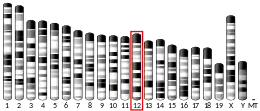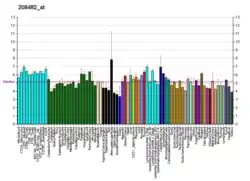Somatostatin receptor 1
Somatostatin receptor type 1 is a protein that in humans is encoded by the SSTR1 gene.[5][6]
Function
Somatostatin acts at many sites to inhibit the release of many hormones and other secretory proteins. The biological effects of somatostatin are probably mediated by a family of G protein-coupled receptors that are expressed in a tissue-specific manner. The encoded protein is a member of the superfamily of somatostatin receptors having seven transmembrane segments, and is expressed in highest levels in jejunum and stomach.[6]
See also
References
- GRCh38: Ensembl release 89: ENSG00000139874 - Ensembl, May 2017
- GRCm38: Ensembl release 89: ENSMUSG00000035431 - Ensembl, May 2017
- "Human PubMed Reference:". National Center for Biotechnology Information, U.S. National Library of Medicine.
- "Mouse PubMed Reference:". National Center for Biotechnology Information, U.S. National Library of Medicine.
- Yamada Y, Stoffel M, Espinosa R, Xiang KS, Seino M, Seino S, Le Beau MM, Bell GI (February 1993). "Human somatostatin receptor genes: localization to human chromosomes 14, 17, and 22 and identification of simple tandem repeat polymorphisms". Genomics. 15 (2): 449–52. doi:10.1006/geno.1993.1088. PMID 8449518.
- "Entrez Gene: SSTR1 somatostatin receptor 1".
Further reading
- Yamada Y, Post SR, Wang K, Tager HS, Bell GI, Seino S (January 1992). "Cloning and functional characterization of a family of human and mouse somatostatin receptors expressed in brain, gastrointestinal tract, and kidney". Proceedings of the National Academy of Sciences of the United States of America. 89 (1): 251–5. doi:10.1073/pnas.89.1.251. PMC 48214. PMID 1346068.
- Fujita T, Yamaji Y, Sato M, Murao K, Takahara J (1994). "Gene expression of somatostatin receptor subtypes, SSTR1 and SSTR2, in human lung cancer cell lines". Life Sciences. 55 (23): 1797–806. doi:10.1016/0024-3205(94)90090-6. PMID 7968260.
- Kaupmann K, Bruns C, Hoyer D, Seuwen K, Lübbert H (September 1993). "Distribution and second messenger coupling of four somatostatin receptor subtypes expressed in brain". FEBS Letters. 331 (1–2): 53–9. doi:10.1016/0014-5793(93)80296-7. PMID 8405411. S2CID 22557713.
- Le Romancer M, Cherifi Y, Levasseur S, Laigneau JP, Peranzi G, Jais P, Lewin MJ, Reyl-Desmars F (1996). "Messenger RNA expression of somatostatin receptor subtypes in human and rat gastric mucosae". Life Sciences. 58 (13): 1091–8. doi:10.1016/0024-3205(96)00063-X. PMID 8622562.
- Fukusumi S, Kitada C, Takekawa S, Kizawa H, Sakamoto J, Miyamoto M, Hinuma S, Kitano K, Fujino M (March 1997). "Identification and characterization of a novel human cortistatin-like peptide". Biochemical and Biophysical Research Communications. 232 (1): 157–63. doi:10.1006/bbrc.1997.6252. PMID 9125122.
- de Lecea L, Ruiz-Lozano P, Danielson PE, Peelle-Kirley J, Foye PE, Frankel WN, Sutcliffe JG (June 1997). "Cloning, mRNA expression, and chromosomal mapping of mouse and human preprocortistatin". Genomics. 42 (3): 499–506. doi:10.1006/geno.1997.4763. PMID 9205124. S2CID 24935564.
- Jaïs P, Terris B, Ruszniewski P, LeRomancer M, Reyl-Desmars F, Vissuzaine C, Cadiot G, Mignon M, Lewin MJ (August 1997). "Somatostatin receptor subtype gene expression in human endocrine gastroentero-pancreatic tumours". European Journal of Clinical Investigation. 27 (8): 639–44. doi:10.1046/j.1365-2362.1997.1740719.x. PMID 9279525. S2CID 23503397.
- Ferone D, van Hagen PM, van Koetsveld PM, Zuijderwijk J, Mooy DM, Lichtenauer-Kaligis EG, Colao A, Bogers AJ, Lombardi G, Lamberts SW, Hofland LJ (January 1999). "In vitro characterization of somatostatin receptors in the human thymus and effects of somatostatin and octreotide on cultured thymic epithelial cells". Endocrinology. 140 (1): 373–80. doi:10.1210/en.140.1.373. PMID 9886848.
- Kumar U, Sasi R, Suresh S, Patel A, Thangaraju M, Metrakos P, Patel SC, Patel YC (January 1999). "Subtype-selective expression of the five somatostatin receptors (hSSTR1-5) in human pancreatic islet cells: a quantitative double-label immunohistochemical analysis". Diabetes. 48 (1): 77–85. doi:10.2337/diabetes.48.1.77. PMID 9892225.
- Rocheville M, Lange DC, Kumar U, Sasi R, Patel RC, Patel YC (March 2000). "Subtypes of the somatostatin receptor assemble as functional homo- and heterodimers". The Journal of Biological Chemistry. 275 (11): 7862–9. doi:10.1074/jbc.275.11.7862. PMID 10713101.
- Schwärzler A, Kreienkamp HJ, Richter D (March 2000). "Interaction of the somatostatin receptor subtype 1 with the human homolog of the Shk1 kinase-binding protein from yeast". The Journal of Biological Chemistry. 275 (13): 9557–62. doi:10.1074/jbc.275.13.9557. PMID 10734105.
- Zatelli MC, Tagliati F, Taylor JE, Rossi R, Culler MD, degli Uberti EC (May 2001). "Somatostatin receptor subtypes 2 and 5 differentially affect proliferation in vitro of the human medullary thyroid carcinoma cell line tt". The Journal of Clinical Endocrinology and Metabolism. 86 (5): 2161–9. doi:10.1210/jc.86.5.2161. PMID 11344221.
- Klisovic DD, O'Dorisio MS, Katz SE, Sall JW, Balster D, O'Dorisio TM, Craig E, Lubow M (September 2001). "Somatostatin receptor gene expression in human ocular tissues: RT-PCR and immunohistochemical study". Investigative Ophthalmology & Visual Science. 42 (10): 2193–201. PMID 11527930.
- Pasquali D, Notaro A, Esposito D, Vassallo P, Bonavolontà G, Bellastella A, Sinisi AA (September 2001). "[Somatostatin receptor genes expression and effects of octreotide on orbital fibroblasts from Graves' ophthalmopathy]". Minerva Endocrinologica. 26 (3): 175–9. PMID 11753241.
- Papotti M, Bongiovanni M, Volante M, Allìa E, Landolfi S, Helboe L, Schindler M, Cole SL, Bussolati G (May 2002). "Expression of somatostatin receptor types 1-5 in 81 cases of gastrointestinal and pancreatic endocrine tumors. A correlative immunohistochemical and reverse-transcriptase polymerase chain reaction analysis". Virchows Archiv. 440 (5): 461–75. doi:10.1007/s00428-002-0609-x. PMID 12021920. S2CID 28584328.
- Zatelli MC, Tagliati F, Piccin D, Taylor JE, Culler MD, Bondanelli M, degli Uberti EC (October 2002). "Somatostatin receptor subtype 1-selective activation reduces cell growth and calcitonin secretion in a human medullary thyroid carcinoma cell line". Biochemical and Biophysical Research Communications. 297 (4): 828–34. doi:10.1016/S0006-291X(02)02307-0. PMID 12359227.
- Ferone D, Pivonello R, Van Hagen PM, Dalm VA, Lichtenauer-Kaligis EG, Waaijers M, Van Koetsveld PM, Mooy DM, Colao A, Minuto F, Lamberts SW, Hofland LJ (November 2002). "Quantitative and functional expression of somatostatin receptor subtypes in human thymocytes". American Journal of Physiology. Endocrinology and Metabolism. 283 (5): E1056-66. doi:10.1152/ajpendo.00205.2001. PMID 12376335.
- Pasquali D, Notaro A, Bonavolonta' G, Vassallo P, Bellastella A, Sinisi AA (November 2002). "Somatostatin receptor genes are expressed in lymphocytes from retroorbital tissues in Graves' disease". The Journal of Clinical Endocrinology and Metabolism. 87 (11): 5125–9. doi:10.1210/jc.2002-020790. PMID 12414882.
- Dizeyi N, Konrad L, Bjartell A, Wu H, Gadaleanu V, Hansson J, Helboe L, Abrahamsson PA (2002). "Localization and mRNA expression of somatostatin receptor subtypes in human prostatic tissue and prostate cancer cell lines". Urologic Oncology. 7 (3): 91–8. doi:10.1016/S1078-1439(01)00173-9. PMID 12474541.
External links
- "Somatostatin Receptors: sst1". IUPHAR Database of Receptors and Ion Channels. International Union of Basic and Clinical Pharmacology.
- somatostatin+receptor+type+1 at the US National Library of Medicine Medical Subject Headings (MeSH)
This article incorporates text from the United States National Library of Medicine, which is in the public domain.
This article is issued from Wikipedia. The text is licensed under Creative Commons - Attribution - Sharealike. Additional terms may apply for the media files.




